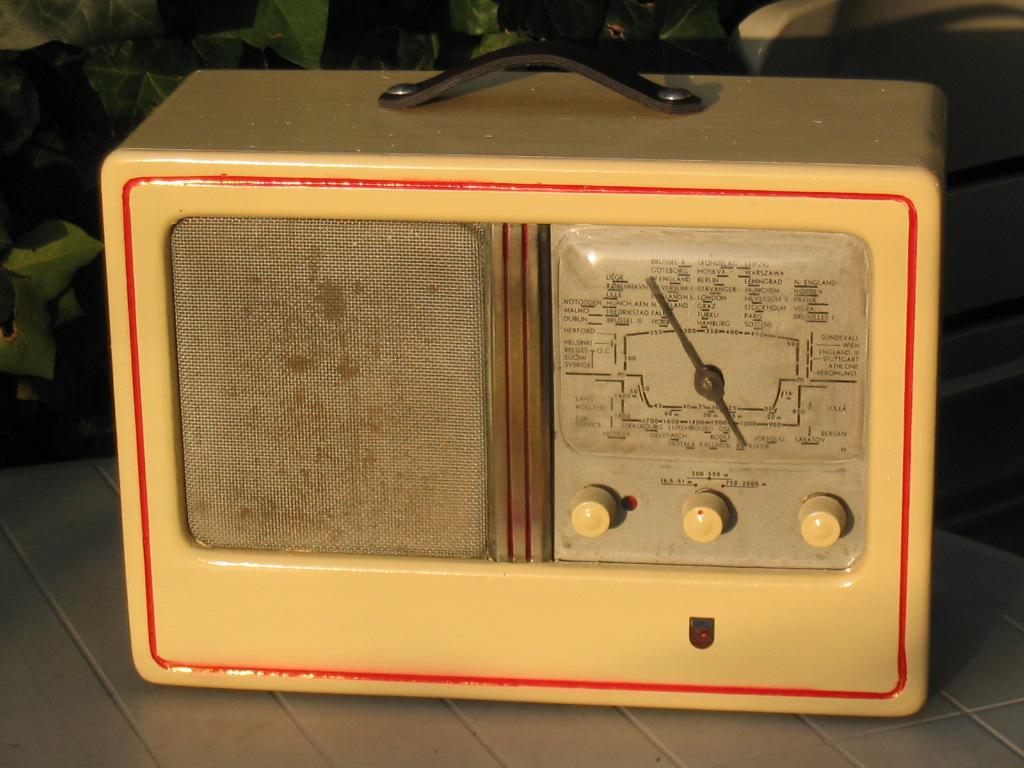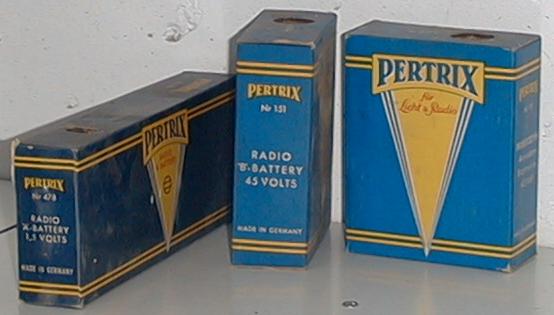Price was 195 guilders.
 French advertisement.
French advertisement.The Radio Historisch Tijdschrift of December 2003, no 107, has an article on this set.

219
Item nr.

Battery operated tube radio.
| Production | The Netherlands, 1949.
Price was 195 guilders. |
|---|---|
| Bands | LW (800-2000m), MW (190-550m), SW (16-50m). |
| Tubes | DK91, DF92, 2x DAF91, 2x DL41. |
| Cabinet | Wood with leatherette skin. Size 36x25x15 cm. Weight 4.4 kg (plus 2 kg for the batteries). |
| Power | Battery, 90V and 1.5V. |
| Documents |  French advertisement. French advertisement.The Radio Historisch Tijdschrift of December 2003, no 107, has an article on this set. |
 It is electrically similar, but has a somewhat cheaper casing than its de luxe brother, the BX484B, designed for stationary use in places without power. In the late forties these places were already getting quite rare in The Netherlands. But these radios could also be used bij emigrants or on board of ships. Nonetheless, it has a carrying handle. On the back one sees not only where to connect antenna and earth, but also an almost complete instruction of how to provide these (left).
It is electrically similar, but has a somewhat cheaper casing than its de luxe brother, the BX484B, designed for stationary use in places without power. In the late forties these places were already getting quite rare in The Netherlands. But these radios could also be used bij emigrants or on board of ships. Nonetheless, it has a carrying handle. On the back one sees not only where to connect antenna and earth, but also an almost complete instruction of how to provide these (left). Normally one thinks of push-pull output stages as a quality improver, but this radio has a push-pull output stage also for reasons of battery economy. Indeed, there are two output tubes, but because they are driven in class B, they have a quite small consumption of plate current: 2.6mA each, where 8mA is usual for a DL41.  The phase inverter only uses 0.14mA, so the plate consumption of the three tubes is about 5.3mA, so we save 2.7mA compared to a layout with a single output tube. The output tubes take 50mA of filament current each, and so does the phase inverter, so we consume 150mA from the A battery. A single output tube usually uses both halves of the filament and takes 100mA alone. So the saving of 2.7mA from the 90V plate battery has a cost of 50mA extra from the A cell. This type of output stage of course makes the radio larger and heavier, and was used mainly for radios intended for stationary use.
The phase inverter only uses 0.14mA, so the plate consumption of the three tubes is about 5.3mA, so we save 2.7mA compared to a layout with a single output tube. The output tubes take 50mA of filament current each, and so does the phase inverter, so we consume 150mA from the A battery. A single output tube usually uses both halves of the filament and takes 100mA alone. So the saving of 2.7mA from the 90V plate battery has a cost of 50mA extra from the A cell. This type of output stage of course makes the radio larger and heavier, and was used mainly for radios intended for stationary use.
| Obtained | 12/2002 from NVHR Swap Meet. |
|---|---|
| Condition | 7. |
| Disposed | Sold 4/2016. |
| Sound sample | PLAY SOUND Mid August, 2005, Israel evacuates its settlements in the Gaza strip. The radio news reports that the atmosphere is tense, but so far there have been no serious incidents |
 When I bought it, it still had batteries inside. Two are Pertrix nr 151, of 45V with the text "Mikrodyn Anoden Batterie" (this was made in Germany). One is type 478, 1.5V, with text "Radio A Battery". All empty, of course, but still. The radio needed some minor repair, replacement of capacitors and cleaning, (and new batteries!) but is basically functional. It performs surprisingly well.
When I bought it, it still had batteries inside. Two are Pertrix nr 151, of 45V with the text "Mikrodyn Anoden Batterie" (this was made in Germany). One is type 478, 1.5V, with text "Radio A Battery". All empty, of course, but still. The radio needed some minor repair, replacement of capacitors and cleaning, (and new batteries!) but is basically functional. It performs surprisingly well. In May 2005 I did some power consumption measurements. With a battery delivering 54V, the current from the battery ranges from 4.2 to 6.0 mA, depending on volume. When switched off, the power consumption is below 1 uA (this currency serves to keep the electrolytic capacitor in good condition).

 One day I used the radio as a demonstration in one of my classes and I actually found it was a bit too dirty for that (right). So after my class I took the radio apart and gave it some fresh paint. For batteries, I have a quite practical solution. Six rechargeable 9V batteries supply the plate voltage, and the heaters are powered from 2 NiMH AA-cells (a single one would suffice as well). The lower voltage of 1.2V actually is enough for the heaters, because to tubes are designed to work still if the original dry cell of 1.5V nominal has run out so far that it delivers only 70% of its voltage.
One day I used the radio as a demonstration in one of my classes and I actually found it was a bit too dirty for that (right). So after my class I took the radio apart and gave it some fresh paint. For batteries, I have a quite practical solution. Six rechargeable 9V batteries supply the plate voltage, and the heaters are powered from 2 NiMH AA-cells (a single one would suffice as well). The lower voltage of 1.2V actually is enough for the heaters, because to tubes are designed to work still if the original dry cell of 1.5V nominal has run out so far that it delivers only 70% of its voltage.